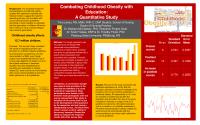Obesity and the university environment: Assessment of the campus and intervention in the student health services
View File(s)
Visitor Statistics
Visits vs Downloads
Visitors - World Map
Top Visiting Countries
| Country | Visits |
|---|
Top Visiting Cities
| City | Visits |
|---|
Visits (last 6 months)
Downloads (last 6 months)
Popular Works for Ortiz, Tina L. by View
| Title | Page Views |
|---|
Popular Works for Ortiz, Tina L. by Download
| Title | Downloads |
|---|
View Citations
Citations
One of the most substantial challenges facing colleges and universities today remains the creation of a healthy campus environment. With more than one-third of college students classified as overweight or obese by body-mass index (BMI) and the known negative health consequences associated with obesity, campuses have a deliberate responsibility to help mitigate this sobering statistic. A significant movement from The American College Health Association (ACHA) to address campus health, Healthy Campus 2020 (HC2020), provides a framework to support campuses in improving the health of their students, staff, and faculty. This project first sought to assess, explore and understand one campus community’s level of engagement in promoting healthy behaviors and creating a healthy environment with respect to the HC2020 objectives. Second, this project introduced and evaluated the impact of a 5As behavioral model training intervention on obesity management for providers in the Student Health Services (SHS). Methods included structured interviews across campus departments, and pre- and post-electronic health record (EHR) reviews to evaluate the SHS intervention as well as a focus group with SHS providers to explore their experience with implementing the 5As intervention. Results from the campus interviews demonstrated that university leaders were cognizant of, and focused on, the campus community and voiced the desire to create a healthy campus environment that accommodated students’ health needs. Despite a number of healthy initiatives existing on campus, and the university’s membership in ACHA, the university did not formally participate in the Healthy Campus 2020 initiative.
Results from the SHS included a sample of 786 pre-intervention EHR records and 1233 post-intervention EHR records of students aged 18 to 24, approximately two-thirds of whom were female. Documentation of BMI by providers demonstrated a small but significant decline from pre-intervention (82.6%) to post-intervention (78.8%). Documentation of overweight and obese diagnostic codes by providers improved from 0.7% pre-intervention to 8.1% post-intervention showing a small but statistically significant increase. Overall, results from the 5As training intervention with providers to improve consistent documentation of overweight and obese students showed minimal success. Providers voiced support for continuing use of 5As but cited time, patient acuity level, and student’s lack of willingness to change as a barriers. Nonetheless, these results open conversation and opportunities for further improvement, for example, initiating SHS protocols to document BMI at all student visits, and configuring electronic health records to facilitate consistent documentation of diagnosis and counseling. Despite evidence of some movement towards a healthier campus and membership in the ACHA, the university falls short of a full commitment to the HC2020 initiative and the resultant healthy campus environment. To ensure success, the university needs to develop a collaborative team prior to committing to the initiative, and ensure involvement of students, faculty, and staff.
This dissertation has also been disseminated through the ProQuest Dissertations and Theses database. Dissertation/thesis number: 28256322; ProQuest document ID: 2490278964. The author still retains copyright.
This item has not gone through this repository's peer-review process, but has been accepted by the indicated university or college in partial fulfillment of the requirements for the specified degree.
| Type | Dissertation |
| Acquisition | Proxy-submission |
| Review Type | None: Degree-based Submission |
| Format | Text-based Document |
| Evidence Level | N/A |
| Research Approach | Translational Research/Evidence-based Practice |
| Keywords | College Students; Body Mass Index; Obesity; Student Health Services; Healthy Behaviors |
| Grantor | The Catholic University of America |
| Advisor | Robert, Rebecca; Flynn, Mary |
| Level | DNP |
| Year | 2021 |
All rights reserved by the author(s) and/or publisher(s) listed in this item record unless relinquished in whole or part by a rights notation or a Creative Commons License present in this item record.
All permission requests should be directed accordingly and not to the Sigma Repository.
All submitting authors or publishers have affirmed that when using material in their work where they do not own copyright, they have obtained permission of the copyright holder prior to submission and the rights holder has been acknowledged as necessary.
Related items
Showing items related by title, author, creator and subjects.
-
Obesity and the university environment
Ortiz, Tina L.One of the most substantial challenges facing colleges today remains the creation of a healthy campus environment. Healthy Campus 2020 objectives helps colleges achieve their goals. -
The limitations of body mass index (BMI) as an obesity assessment scale and the implications for practice: A nursing perspective
Impey, Sinead (2016-03-21)Session presented on Saturday, November 7, 2015 and Sunday, November 8, 2015: Rising obesity rates have a significant impact on morbidity, mortality and subsequent delivery of health services globally. Therefore accurate ... -
Lived experience of being an obese registered nurse: A phenomenological inquiry
Rodgers, TrinaResearch has shown obesity is a significant problem affecting the general-public and is increasing in prevalence among health care providers. The purpose of this descriptive phenomenological study was to understand the ... -
Waist circumference as a measurement tool for pediatric obesity
Weiser, Jeanette Marlene (2016-03-21)Session presented on Monday, November 9, 2015 and Tuesday, November 10, 2015: Background: The focus of this project was exploring methods for the early identification of childhood obesity. Significance: With the advent ... -
Combating childhood obesity with education: A quantitative and qualitative study
Larery, Trina Marie (2016-09-16)Session presented on Sunday, September 18, 2016: The purpose of this study was to provide an educational program to providers and nurse practitioner students in order to evaluate whether an increase in knowledge and ...





